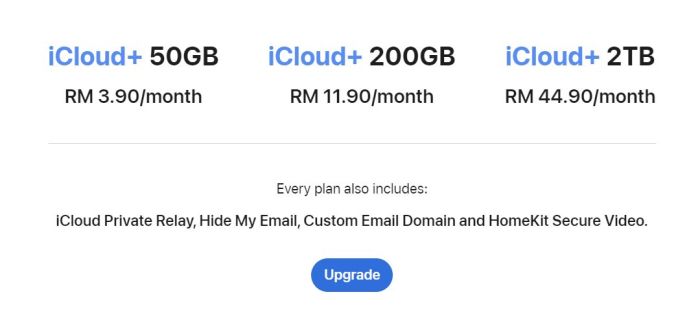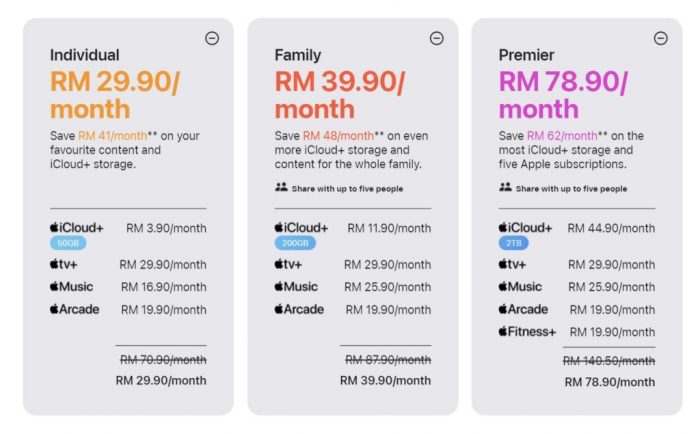Best iCloud+ plans for Apple device backup are crucial for safeguarding your data. This guide delves into various storage tiers, backup strategies, and potential limitations, empowering you to choose the optimal plan for your Apple devices. Understanding the different iCloud+ options, from basic to premium, is essential to effectively manage your data and ensure a seamless backup process.
We’ll compare iCloud+ plans, explore different backup strategies for iPhones, iPads, and Macs, and discuss potential limitations. Additionally, we’ll examine alternative cloud storage solutions for those needing more extensive backup options.
iCloud+ Plan Comparison

Source: soyacincau.com
Choosing the right iCloud+ plan is crucial for managing your Apple device backups effectively. This comparison dives into the various storage tiers, helping you select the best option based on your storage needs and budget. Understanding the available storage options, pricing, and key features will empower you to make an informed decision.
Storage Tier Details
Different iCloud+ plans offer varying storage capacities, impacting the number of Apple devices you can back up and the amount of data you can store. The table below Artikels the available storage options, their corresponding costs, and their suitability for different backup requirements.
| Plan Name | Storage Size | Price (USD) | Key Features |
|---|---|---|---|
| iCloud+ 50GB | 50 GB | $0.99/month | Basic storage for essential backups. Suitable for smaller device backups or infrequent data transfers. |
| iCloud+ 200GB | 200 GB | $2.99/month | Increased storage for more comprehensive backups, ideal for users with multiple devices or large media libraries. |
| iCloud+ 2TB | 2 TB | $9.99/month | Significant storage capacity for extensive backups of multiple devices and substantial data sets. Suitable for professional or demanding users. |
| iCloud+ 8TB | 8 TB | $29.99/month | Exceptional storage capacity for archiving massive data volumes and ensuring the long-term retention of significant data sets. Aimed at enterprise-level needs or exceptional individual demands. |
Backup Options and Their Impact
Automatic backups are a significant feature of iCloud+ plans, ensuring regular and consistent data protection. Manual backups offer more control over the backup process, allowing you to initiate backups on demand. The choice between automatic and manual backups impacts data management and storage costs.
- Automatic backups, scheduled by the system, minimize user intervention and maintain a consistent backup schedule, reducing the likelihood of missed backups. This approach can be particularly beneficial for maintaining a current and up-to-date backup of frequently modified files or data. However, the continuous nature of automatic backups might lead to slightly higher storage costs over time.
- Manual backups provide greater control over the timing of the backup process. Users can choose when to initiate a backup, potentially optimizing storage costs if data changes are infrequent. However, this requires active user intervention and carries a risk of missed backups or incomplete data backups.
Adequacy of Storage for Device Backups
The storage capacity of an iCloud+ plan directly impacts the number of devices that can be backed up and the amount of data that can be stored. A 50GB plan may be sufficient for a single iPhone with limited media content, while a 2TB plan offers substantial storage for extensive device backups and large media libraries. Understanding your backup needs is key to selecting the appropriate plan.
Apple Device Backup Strategies: Best ICloud+ Plans For Apple Device Backup
Backing up your Apple devices is crucial for safeguarding your data. Icloud+ offers a reliable solution for this, allowing you to effortlessly back up your iPhone, iPad, and Mac data to the cloud. This comprehensive guide Artikels various backup strategies and provides step-by-step instructions for setting up, reviewing, and managing these backups effectively.Effective data protection is paramount in today’s digital landscape.
Regular backups are essential to prevent data loss from various unforeseen circumstances, such as device damage, accidental deletion, or software glitches. Understanding the different backup strategies and actively managing your iCloud+ settings can significantly reduce the risk of data loss and facilitate quick recovery.
Backup Strategies for Apple Devices
Various strategies for backing up your Apple devices using iCloud+ cater to diverse needs and preferences. Choosing the right strategy depends on your storage needs and how frequently you need to access or update your data. This includes opting for automatic backups or performing manual backups as needed.
Setting Up Automatic Backups
Setting up automatic backups for your iPhone, iPad, and Mac ensures your data is consistently saved to iCloud+. This process is straightforward and can be tailored to your specific needs.
- iPhone/iPad: To enable automatic backups, navigate to Settings > Your Name > iCloud > iCloud Backup. Turn on the toggle next to iCloud Backup. You can choose to back up your device when it’s on Wi-Fi only, or whenever it’s plugged in and connected to a power source.
- Mac: Enabling automatic backups on your Mac is equally simple. Open System Preferences > Apple ID > iCloud. Check the box next to iCloud Backup. You can specify which files and folders to include in the backup. This can be configured to back up only when the Mac is on Wi-Fi or connected to a power source, or both.
Reviewing and Managing Backup Settings
Regularly reviewing and managing your backup settings is essential for optimizing storage utilization and ensuring data integrity. This involves checking for unused storage space, deleting old backups, and updating settings as needed.
- Checking Backup Storage: Access your iCloud storage settings to check the amount of space used by your backups. This will help you determine if you need to free up space or consider a higher iCloud+ plan.
- Deleting Old Backups: iCloud+ allows you to delete old backups that you no longer need. This will free up storage space and prevent unnecessary clutter. Be mindful of how long you need to retain backups before deleting them.
- Updating Settings: Update your backup settings to ensure your device is backing up the desired files and folders. Regularly checking and adjusting these settings will prevent unwanted data from being included or excluded from backups.
Preventing Data Loss and Ensuring Data Recovery
Best practices for preventing data loss and ensuring data recovery encompass regular backups, careful device handling, and secure passwords. The process of data recovery involves accessing and restoring your data from your iCloud+ backups.
- Regular Backups: Implementing a regular backup schedule ensures you have a recent copy of your data. This helps prevent loss in case of accidental deletion or device malfunction. Schedule regular automatic backups to ensure consistent protection.
- Secure Passwords: Protect your Apple ID and iCloud account with a strong password to prevent unauthorized access to your backups. Regularly update your passwords for added security.
- Device Care: Handle your devices with care to avoid physical damage that could lead to data loss. Be mindful of your device’s surroundings and potential threats.
Managing and Restoring Backups
Managing and restoring backups from iCloud+ is straightforward. This process allows you to retrieve your data from previous backups.
- Accessing iCloud Backup: Access your iCloud backup settings to view your backup history and restore from a specific point in time. You can use the Finder on your Mac or the iCloud website.
- Restoring Data: Follow the on-screen instructions to restore your data from a previous backup. This may involve restoring to a new device or overwriting existing data. Be cautious when restoring data to prevent data conflicts.
iCloud+ Backup Limitations and Alternatives

Source: soyacincau.com
iCloud+ offers a convenient and readily available backup solution for Apple devices, but it’s not a one-size-fits-all solution. Understanding its limitations is crucial for ensuring comprehensive data protection. This section explores potential constraints and presents alternative backup strategies.iCloud+ storage is limited, and some data types might not be ideal candidates for automatic backups. Consequently, supplementary strategies can help manage backup needs and optimize data protection.
Alternatives offer diverse approaches to data security, catering to various storage requirements and data types.
iCloud+ Backup Limitations
iCloud+ storage space is finite, and backing up large files, like high-resolution photos, videos, or extensive documents, can quickly exhaust the allotted storage. Furthermore, specific data types, like locally-created databases or complex multimedia projects, may not be suitable for automatic iCloud+ backups due to size constraints or format compatibility issues.
Alternative Backup Solutions
For exceeding iCloud+ storage limits, external hard drives, cloud storage services like Google Drive, Dropbox, or OneDrive, or a combination of these, provide additional space. These options offer scalable storage and often feature advanced management tools.
Comparison of Cloud Storage Services for Device Backups, Best iCloud+ plans for Apple device backup
| Service | Storage Capacity | Price | Key Features |
|---|---|---|---|
| iCloud+ | 50GB to 2TB+ (tiered plans) | Monthly subscription | Automatic backups, seamless integration with Apple devices, file sharing |
| Google Drive | 15GB to 30TB+ (tiered plans) | Monthly subscription | Extensive file sharing options, good for collaboration, support for various file types |
| Dropbox | 2GB to 1TB+ (tiered plans) | Monthly subscription | Easy file syncing, accessible across devices, strong focus on collaboration and teamwork |
| OneDrive | 5GB to 1TB+ (tiered plans) | Monthly subscription | Strong integration with Microsoft applications, robust security features, supports various file types |
This table highlights the varying storage capacities, pricing structures, and key features of popular cloud storage services. Careful consideration of these factors is essential when selecting an alternative to iCloud+.
Integrating Alternative Backup Methods with Apple Device Management
Integrating external backup solutions with Apple device management can be achieved through a combination of manual and automated processes. Manually copying large files to external drives is a straightforward approach. Cloud-based services often feature features like automatic file syncing or scheduled backups. A hybrid approach, combining manual backups for critical files with automatic cloud backups for frequently modified data, can be very effective.
This strategy can protect data across different mediums and ensure recovery in various scenarios.
Closing Notes
In conclusion, choosing the right iCloud+ plan for backing up your Apple devices hinges on your specific storage needs and budget. By understanding the nuances of different plans, backup strategies, and potential limitations, you can confidently safeguard your valuable data. This comprehensive guide has provided a clear roadmap for optimizing your iCloud+ experience.